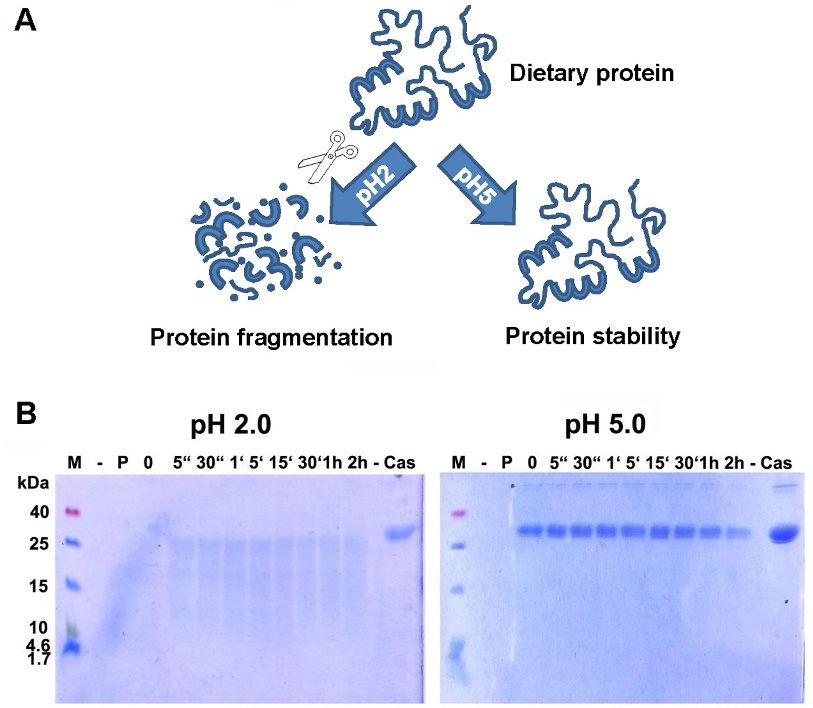Estratto dal capitolo: “Digestione delle proteine: l’acido gastrico è fondamentale per un’adeguata digestione delle proteine e la prevenzione delle allergie alimentari
La digestione delle proteine- e quindi la maggior parte degli allergeni alimentari – inizia nello stomaco. Un basso pH è essenziale per l’attivazione dell’enzima pepsinogeno in pepsina [92]. Tuttavia, se vengono somministrati farmaci che sopprimono l’acido, il pH aumenta considerevolmente (ad esempio, fino a 5 con inibitori della pompa protonica, PPI). Come mostrato in molti precedenti esperimenti in vitro, la corretta digestione da parte della pepsina è ostacolata dall’aumento del pH (Figura 1), e questo vale per un certo numero di proteine alimentari, come la nocciola [93], il merluzzo bianco [94], il latte [ 95] e caseina (Figura 1).

(A) Digestion of proteins is hampered when pH increases. Proteins, as part of the daily diet, are digested at low pH and broken down into smaller fragments, whereas a higher pH blocks proper digestion. The resulting bigger fragments or proteins are more easily recognized by the immune system, leading to an increased risk for sensitization or allergic reactions. (B) Digestion of α-casein in vitro is hampered when pH increases. Casein was readily broken down by enzymatic digestion with pepsin at pH 2.0, but remained totally intact even after 2 h of incubation with enzyme at pH 5.0. M: molecular weight marker; -: empty lane; P: pepsin; 0: no incubation time, reaction stopped immediately; “: seconds; ‘: minutes; h: hour(s); Cas: casein.
It is clear that food intake per se changes the gastric pH, which can increase from a median fasting baseline value of pH 1 to pH 4.5 with ingestion of the meal [96]. The buffer capacity thereby depends on the food composition and meal constituents. However, this effect is transient, as ongoing acid production is responsible for a subsequent decrease of the pH, which returns to ca. pH 1 about 260 min after the start of the meal [96]. Applying acid-suppressing substances can disturb this process and induce a long-lasting elevation of the gastric pH up to 5.0 [97]. In a number of food animal models, the effect of this pH-elevation was shown in vivo, as feeding digestion-labile antigen under concomitant acid-suppression resulted in a clear Th2-response and allergy symptoms [98,99,100,101,102,103,104]. This acquired sensitization capacity was true for different proteins, like codfish, hazelnut or ovalbumin, and even oral drugs, in the mouse model [99] and also in humans [105]. Importantly, several types of acid-suppressing or -neutralizing medication, like base powder [106], sucralfate [102], H2-receptor blockers [107] and proton pump inhibitors [101] produced this effect. The outcome of the immune response may depend on timing of the anti-acid drug application in relation to food uptake, and on the dosage of the antigen [101,108]. Gastric acid suppression might further impact on intestinal pH levels and consequently on protein digestion in the intestine [109]. This assumption, however, requires further investigations in clinical settings.” “The Effect of Digestion and Digestibility on Allergenicity of Food Isabella Pali-Scholl, Eva Untersmayr, Martina Klems and Erika Jensen-Jarolim. Published: 21 August 2018 Nutrients.”
L’effetto della digestione e della digeribilità sull’allergenicità degli alimenti (prima parte)
Approfondimenti
The Effect of Digestion and Digestibility on Allergenicity of Food
